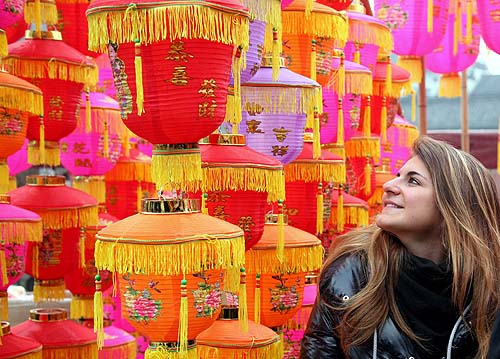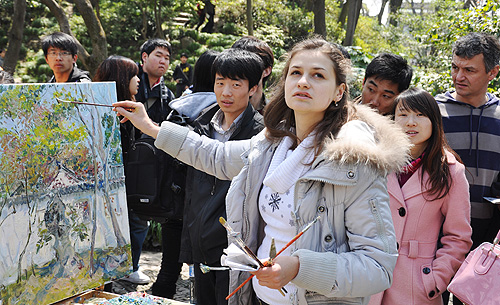|
 |
|
TRADITIONAL FLAVOR: A foreign tourist appreciates Chinese lanterns in Nanjing Confucius Temple on February 3 (WANG XIN) |
May 19 is a special day in China's history. On that day 400 years ago, Xu Xiake (1587-1641), well-known geographer, traveler and explorer of the Ming Dynasty (1368-1644), started a lifelong journey, leading to the publication of the monumental Xu Xiake's Travel Notes, known for its detailed and accurate geographical information. The book also provided valuable insight into local customs and habits.
On March 30, 2011, the State Council of China announced that May 19 each year will be China's National Tourism Day.
Booming industry
 |
|
BEAUTIFUL SCENERY: A foreign tourist creates an oil painting in the Zhuozheng Garden in Suzhou, Jiangsu Province, a city famous for its Chinese landscape gardens in April (ZHU GUIGEN) |
The Pacific Asia Travel Association (PATA) announced during its 60th Anniversary Conference in Beijing on April 9-13 that China has now become the world's third largest tourist destination and the fourth largest source market for outbound tourism.
"The country's tourist industry has stepped into a golden era of rapid development," said Chinese Vice Premier Wang Qishan at the PATA conference. "China will promote the sustainable growth of tourism and develop it into a strategic pillar industry of the national economy during the 12th Five-Year Plan (2011-15)."
A report of the UN World Tourism Organization said in 2010 China registered 2.1 billion domestic travels, up 10.6 percent compared to the previous year, and 55.66 million inbound overnight tourist arrivals, up 9.4 percent year on year. Tourism revenues in China last year reached 1.57 trillion yuan ($241.5 billion), up 21.7 percent year on year, and foreign exchange earnings from tourism came to $45.8 billion, up 15.5 percent year on year. "As early as the 1990s, the international tourism revenues already made up more than 10 percent of the global GDP," said Wu Wenxue, an official from the China National Tourism Administration (CNTA). "Throughout the world, tourism has replaced auto and oil to be the No.1 industry."
CNTA statistics show China's tourism industry has maintained sound momentum of steady and fast development during the past 30 years, with its annual average growth rate at nearly 20 percent. In the previous five years there has been an annual average increase of 15 percent in total tourism revenues, 3.5 percent in inbound overnight tourist arrivals, and 19 percent for outbound tourists.
Domestically, the average number of trips per capita was 1.5, and tourism consumption contributed over 10 percent of the total expenditure in travel. The number of China's outbound tourists reached 57.39 million last year, an increase of 20.4 percent year on year.
China has over 20,000 frequently visited scenic spots, 15,000 travel agencies, and more than 1 million professional tour guides. "After some important events, such as the Beijing Olympic Games and the World Expo in Shanghai, China is becoming a new tourist attraction," said Di Kangfei, Deputy Director of the Representative Office of CNTA in Frankfurt, Germany. "With fundamental improvements of infrastructure facilities for communication and accommodation, the country is very well prepared to welcome guests from all over the world."
In terms of the domestic market, an article carried in China Youth Daily on April 12 said last year the per-capita disposable income for urban residents hit 19,109 yuan ($2,939) and 5,919 yuan ($910.6) for rural residents. As well, Chinese people now enjoy a total of 115 official holidays for the whole year, while having an annual leave of five to 15 days with pay. "All of these have substantially facilitated the rapid development of tourist industry."
In the next five years, China will gradually put a plan on citizens' tourism into effect. "When per-capita GDP reaches $3,000 to $5,000 in a country, as a rule, tourism and consumption spring dynamically," said Zhu Shanzhong, CNTA's Vice Chairman. "Per capita GDP in China is expected to amount to $4,000 or so, suggesting that an era of tourism is coming here."
|
